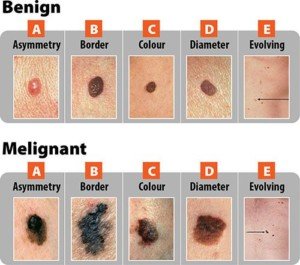
If you’re a teen, it’s not too early to check your lifelong moles every month for signs of melanoma—especially if you’ve spent a lot of time over the years in the sun without sunscreen.
You may also have “built-in” risk factors for melanoma, and being a teenager does not make you immune to this deadliest of all skin cancers.
For example, if you have a lot of moles, this is a risk factor.
Another risk factor is if many of these moles look odd or funny and have asymmetry.
A third risk factor is your natural coloring: red or blonde hair, light eyes, pale or “peaches and cream” skin – the kind that can’t tan well, if at all.
Teens have also been known to frequent tanning beds.
One-third of melanomas overall arise from pre-existing moles. However, in many cases an adult (especially an older adult) has no idea how long they had a mole that began evolving into cancer.
It may have been there all their life, since birth or since very early childhood. Or, it could have developed in their 20s or 30s or older.
Teens often do not know if a particular mole has “always been there,” especially if it’s in an obscure location.
When new moles form in locations that are seen nearly every day, it’s easy to tell if they’re new.
“Although very rare, there is always a chance that melanoma can occur from moles that are present since birth,” in teenagers, says Dr. Tess Mauricio, MD, FAAD, a leading board certified dermatologist from Stanford University Medical School and CEO of MBeautyClinic.com.
Dr. Mauricio explains, “This is the reason to watch for dynamic changes in symmetry, color, shape, size and symptomatology. Any old mole that starts changing in appearance, hurting, itching or bleeding needs to be evaluated and biopsied to be safe.”
Though teens should be vigilant with monthly skin exams (early stage melanoma is highly curable), this doesn’t mean you should worry about this disease! Live your life and have fun—but USE SUNSCREEN.

You should do more worrying about other things that are far more likely to kill you, such as careless driving (by your or a friend), taking illegal drugs, alcohol intoxication poisoning, mixing drugs with alcohol and attempting dangerous stunts like riding on top of cars. Even texting while walking can get you killed by an inattentive driver.
Take inventory of your moles.
Take particular note of those you can view easily such as the ones on your face, shoulders, arms, abdomen and front of your legs. Get to know their features, shapes, sizes, color variations, etc.

Have a dermatologist examine all of them to establish a baseline. Then inspect them every month.
This way if there are any changes in the future, you will easily detect them.
 Dr. Mauricio is an internationally recognized cosmetic surgeon and the youngest woman to hold the position of President of The San Diego Society for Dermatologic Surgery.
Dr. Mauricio is an internationally recognized cosmetic surgeon and the youngest woman to hold the position of President of The San Diego Society for Dermatologic Surgery.
 Lorra Garrick has been covering medical, fitness and cybersecurity topics for many years, having written thousands of articles for print magazines and websites, including as a ghostwriter. She’s also a former ACE-certified personal trainer.
Lorra Garrick has been covering medical, fitness and cybersecurity topics for many years, having written thousands of articles for print magazines and websites, including as a ghostwriter. She’s also a former ACE-certified personal trainer.
.









































